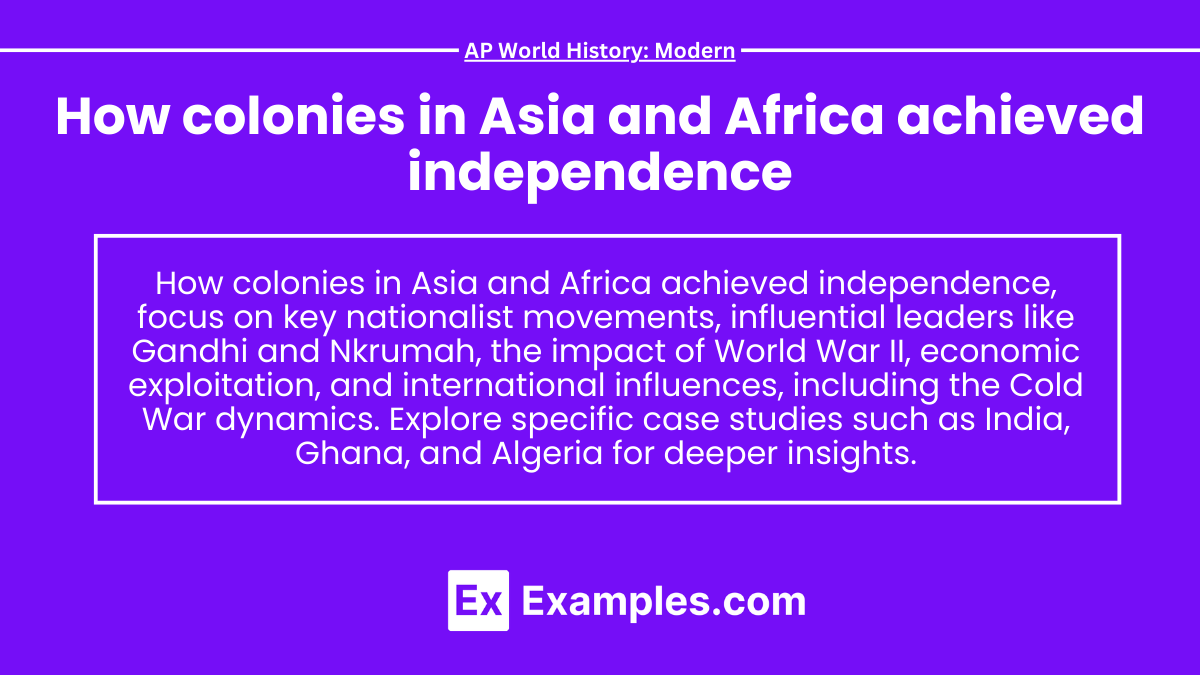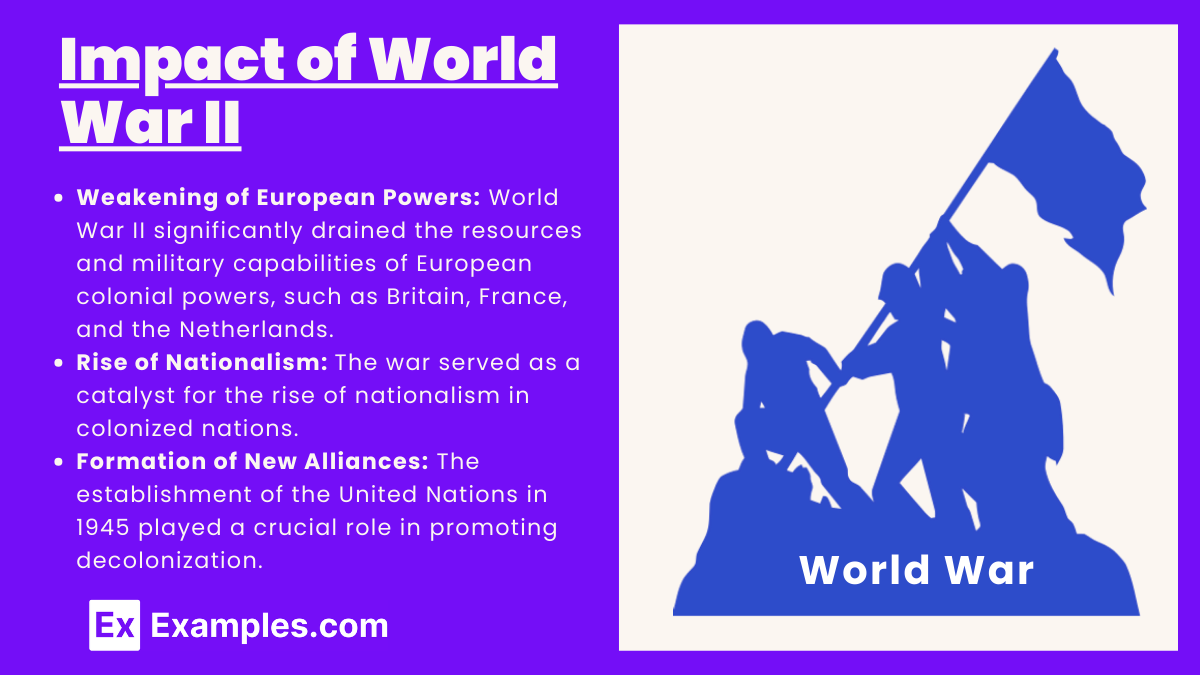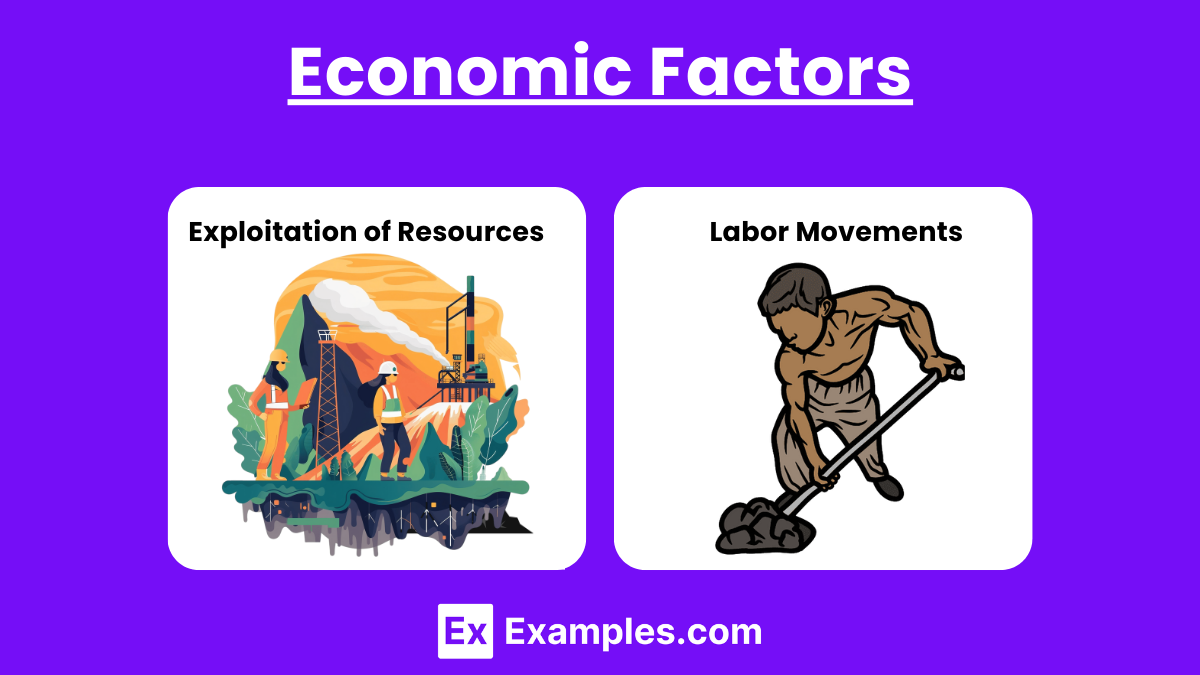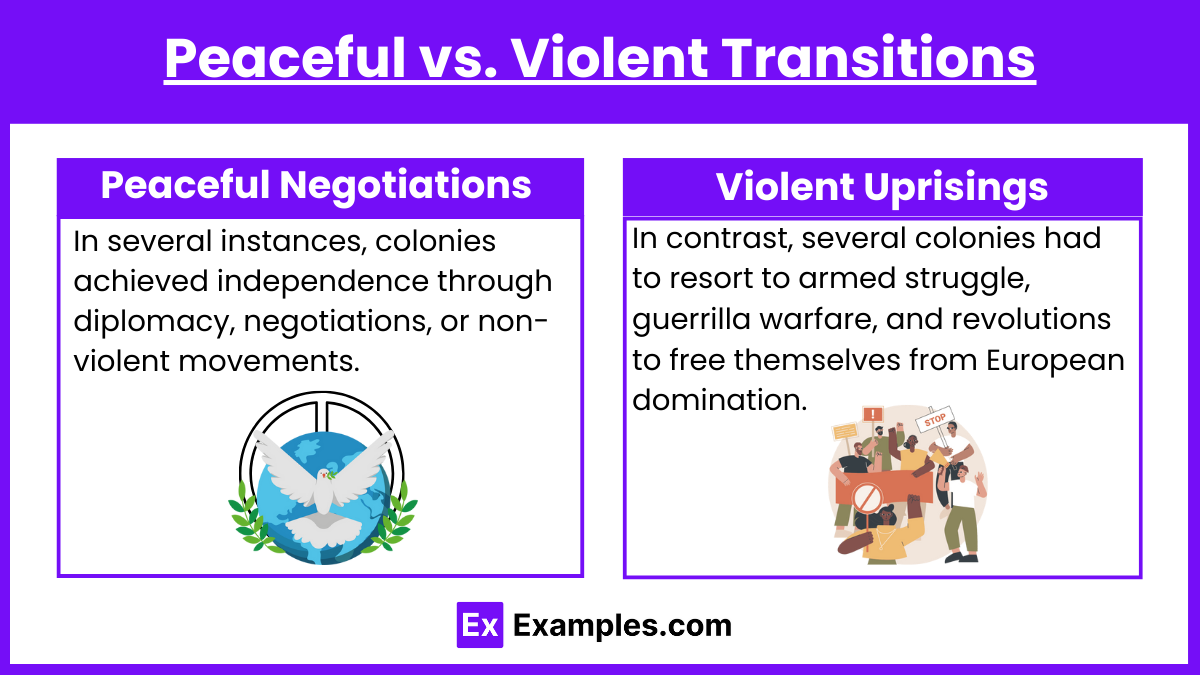Colonies in Asia and Africa achieved independence through nationalist movements driven by leaders like Gandhi and Nkrumah, influenced by World War II's weakening of colonial powers. Economic exploitation spurred resistance, while global trends and Cold War dynamics offered support. Strategies included peaceful protests and armed struggles, leading to significant milestones like India's partition and Ghana's peaceful transition in 1957.
Free AP World History: Modern Practice Test
Learning Objective
In studying how Asia and Africa achieved independence for AP World History: Modern, you should aim to understand the various nationalist movements, the impact of World War II, the role of key leaders, and the economic and social factors that fueled the quest for self-determination.
1. Impact of World War II
World War II drastically reshaped global politics, leading to the rise of superpowers, decolonization, the establishment of the United Nations, and significant social, economic, and technological changes worldwide.
Weakening of European Powers
World War II significantly drained the resources and military capabilities of European colonial powers, such as Britain, France, and the Netherlands. The extensive destruction and economic strain from the war left these nations unable to maintain control over their colonies. Financial instability, coupled with the loss of manpower and military strength, created an environment where colonial powers could no longer suppress rising nationalist movements effectively. This weakness prompted many colonies to challenge colonial rule and assert their desire for independence.
Rise of Nationalism
The war served as a catalyst for the rise of nationalism in colonized nations. During the conflict, many colonial subjects fought alongside their European rulers, gaining exposure to ideals of self-determination and democratic governance. The Atlantic Charter of 1941, which proclaimed the right of all peoples to choose their form of government, further fueled nationalist sentiments. Colonized populations, inspired by these ideals and disillusioned by their treatment, increasingly demanded independence and the right to self-governance.
Formation of New Alliances
The establishment of the United Nations in 1945 played a crucial role in promoting decolonization. The UN emphasized principles such as self-determination and human rights, providing a platform for colonized nations to voice their aspirations for independence. The organization supported anti-colonial movements and encouraged nations to seek sovereignty, thereby legitimizing the struggles of colonized peoples on a global stage. The UN’s emphasis on decolonization and the right to self-governance further mobilized nationalist movements worldwide.
2. Nationalist Movements
Emergence of National Leaders
Nationalist movements in Asia and Africa were often led by charismatic figures who became symbols of their respective struggles. Leaders such as Mahatma Gandhi in India, who advocated for nonviolent resistance, and Kwame Nkrumah in Ghana, who championed Pan-Africanism, played vital roles in mobilizing support for independence. Their vision and leadership inspired widespread participation in the struggle for freedom and established a sense of national identity.
Nonviolent Resistance
Many nationalist leaders, particularly in India, promoted nonviolent resistance as a means to challenge colonial rule. Gandhi’s Salt March in 1930 exemplified this approach, where he led a massive civil disobedience campaign against British salt taxes. This event not only galvanized Indian support for independence but also attracted international attention to the cause. The strategy of nonviolent protest became a powerful tool in various independence movements, demonstrating the potential for achieving political change without resorting to violence.
3. Economic Factors
Exploitation of Resources
The colonial economies were structured to benefit European powers, often at the expense of local populations. Colonized nations faced the exploitation of their natural resources, with profits flowing back to the metropole while local communities remained impoverished. This economic disparity led to widespread discontent and a growing desire for economic autonomy. Nationalist leaders framed the independence struggle not only as a fight for political freedom but also as a means to reclaim economic control and develop their nations.
Labor Movements
Labor movements emerged as a significant force in the independence struggles, as workers organized strikes and protests against colonial exploitation. Workers demanded better wages, improved working conditions, and the right to organize. These movements often linked economic grievances with the broader nationalist agenda, fostering solidarity among different social groups. Labor unrest highlighted the contradictions of colonial rule, as the colonizers sought to maintain control while local workers challenged their authority.
4. Peaceful vs. Violent Transitions
Peaceful Negotiations:
In several instances, colonies achieved independence through diplomacy, negotiations, or non-violent movements. European powers often recognized that maintaining control over distant colonies was becoming economically unfeasible and politically undesirable.
Many countries, like India and Ghana, gained independence through relatively peaceful means, often involving negotiations between nationalist leaders and colonial governments.
Violent Uprisings:
In contrast, several colonies had to resort to armed struggle, guerrilla warfare, and revolutions to free themselves from European domination. European powers often resisted relinquishing control, particularly when they had significant settler populations or economic interests.
In contrast, places like Algeria, Kenya, and Vietnam saw prolonged violent struggles, with heavy losses on both sides before achieving independence.
Examples
Example 1: India (1947)
India achieved independence from British rule through a combination of nonviolent resistance, civil disobedience, and mass mobilization led by figures like Mahatma Gandhi. The Salt March in 1930 exemplified this strategy. India’s independence was marked by the painful partition into India and Pakistan, which created significant communal tensions.
Example 2: Ghana (1957)
Ghana became the first African nation to gain independence from colonial rule under British governance. Led by Kwame Nkrumah, the independence movement employed peaceful protests and mobilized labor movements. Nkrumah’s advocacy for Pan-Africanism inspired other African nations to pursue their independence, leading to a wave of decolonization across the continent.
Example 3: Algeria (1962)
Algeria’s struggle for independence from France involved a brutal armed conflict led by the National Liberation Front (FLN). The war began in 1954 and involved widespread guerrilla warfare, eventually attracting international attention. After years of violent struggle and significant loss of life, Algeria achieved independence in 1962, fundamentally reshaping its national identity.
Example 4: Indonesia (1945)
Indonesia declared independence from Dutch colonial rule in 1945, following the weakening of Dutch power during World War II. Led by Sukarno, the independence movement combined nationalistic fervor with international support. The subsequent Indonesian National Revolution involved armed resistance against Dutch attempts to reclaim control, leading to full sovereignty in 1949.
Example 5: Kenya (1963)
Kenya’s path to independence from British colonial rule involved both peaceful protests and violent uprisings, notably the Mau Mau Rebellion. The movement, which began in the 1950s, highlighted the brutal realities of colonial exploitation. Following negotiations and mounting pressure, Kenya achieved independence in 1963, with Jomo Kenyatta becoming its first president.
MCQs
Question 1
Which of the following leaders is most associated with the nonviolent resistance movement in India?
A) Mahatma Gandhi
B) Nelson Mandela
C) Jomo Kenyatta
D) Kwame Nkrumah
Correct Answer: A) Mahatma Gandhi
Explanation: Mahatma Gandhi championed nonviolent resistance, leading India's independence movement through peaceful protests and civil disobedience, significantly impacting both India and global decolonization efforts.
Question 2
What was a significant factor in Ghana's independence movement in 1957?
A) Armed struggle
B) Trade agreements
C) Pan-Africanism
D) Economic sanctions
Correct Answer: C) Pan-Africanism
Explanation: Ghana's independence was driven by Pan-Africanism, emphasizing unity and solidarity among African nations, significantly inspiring subsequent independence movements across the continent.
Question 3
What was the primary outcome of the Algerian War of Independence (1954-1962)?
A) Economic cooperation with France
B) Establishment of a one-party state
C) Division of Algeria into multiple states
D) End of colonial rule and independence for Algeria
Correct Answer: D) End of colonial rule and independence for Algeria
Explanation: The Algerian War led to independence from French colonial rule in 1962, demonstrating the effectiveness of armed struggle in decolonization efforts.






